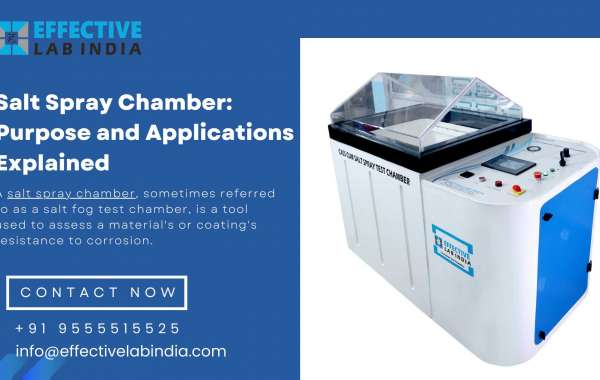A salt spray chamber , sometimes referred to as a salt fog test chamber, is a tool used to assess a material's or coating's resistance to corrosion. By producing a fine mist of saltwater solution that settles on the test samples and imitating the effects of extended exposure to marine or industrial atmospheres, it creates the impression of a harsh, corrosive environment.
Importance of Corrosion Testing
Products and materials that are subjected to corrosion may have much shorter lifespans and perform worse. By knowing how different materials react in corrosive situations, producers can make their goods more reliable and durable. This is especially important for businesses where performance and safety are critical.
Understanding Salt Spray Test Chambers
Components of a Salt Spray Chamber
A sealed testing cabinet, a reservoir for salt solution, a heating system, and a spray nozzle make up a conventional salt spray chamber . The cabinet's design aims to preserve a constant atmosphere with regulated humidity and temperature. The salt solution is atomized by the spray nozzle, resulting in a fine mist that even settles on the test samples.
How Does a Salt Spray Test Chamber Work?
A saltwater solution, typically 5% sodium chloride, is sprayed into the test chamber’s air to run it. The test items, which are usually coated or metallic objects, are subsequently covered with mist. To hasten the corrosion process, a precise temperature of approximately 35°C is maintained inside the chamber. Depending on the needs, tests may last for several hours, days, or even weeks.
Applications of Salt Spray Test Chambers
Automotive Industry
The corrosion resistance of automobile bodywork, chassis parts, and other parts exposed to road salt and moisture is assessed in the automotive industry through the use of salt spray testing.
Aerospace Industry
Extensive testing with salt spray is performed on aerospace components, including as airframe structures and fasteners, to guarantee their resistance to the corrosive effects of high-altitude settings and salted air.
Marine Industry
Seawater is extremely corrosive to marine equipment, which includes ships, offshore constructions, and underwater pipes. The durability of the materials used in these applications can be evaluated with the aid of salt spray testing.
Electronics Industry
To guarantee dependable operation over time, electronic components—especially those used in severe or outdoor environments—are tested for corrosion resistance.
Construction and Infrastructure
Materials that are used in construction, such as structural components, coatings, and steel rebar, are tested to make sure they can withstand exposure to weather and corrosive elements.
Paints and Coatings Industry
Salt spray testing is essential for quality assurance since paints and protective coatings are assessed based on how well they can stop corrosion on metal surfaces.
Benefits of Using Salt Spray Test Chambers
Accelerated Testing
Manufacturers can evaluate the corrosion resistance of materials and coatings more quickly thanks to the expedited testing conditions offered by salt spray chambers.
Standardized Testing Conditions
Standardized and repeatable testing conditions are provided by these chambers, guaranteeing consistent outcomes and comparability between various tests and samples.
Cost-Effective
Manufacturers can reduce expenses related to material failures and product recalls by spotting possible corrosion problems early in the development phase.
Predictive Maintenance
Predictive maintenance and the identification of materials and coatings that need to be improved before being deployed in real-world situations can both benefit from routine salt spray testing.
Types of Corrosion Tested
Uniform Corrosion
Testing with salt spray aids in determining the material’s overall corrosion resistance because uniform corrosion happens uniformly across its surface.
Pitting Corrosion
Little, isolated pits or holes are the product of pitting corrosion. Tests using salt spray can identify materials that are susceptible to this kind of corrosion.
Crevice Corrosion
In small areas where the salt solution may become trapped, crevice corrosion happens. Salt spray chambers are useful for assessing a material’s ability to withstand corrosion in cracks.
Galvanic Corrosion
Galvanic corrosion can happen when two distinct metals come into contact. Testing with salt spray can mimic this reaction and spot possible problems.
Setting Up a Salt Spray Test
Preparing the Test Sample
To guarantee accurate findings, the test sample needs to be cleaned and processed under established protocols.
Adjusting the Chamber Settings
Temperature, humidity, and salt solution concentration in the chamber must all be changed to meet the demands of the particular test.
Running the Test
The test continues for a predefined amount of time after the samples are placed within the chamber, with frequent inspections and maintenance performed as needed.
Interpreting Test Results
Visual Inspection
Examining the test samples visually entails looking for corrosion indicators like rust, pitting, or discoloration.
Microscopic Examination
The degree of material degradation and more intricate corrosion patterns can be seen by microscopic analysis.
Data Analysis
Measuring the depth and rate of corrosion is one aspect of data analysis that offers important information about the performance of the material.
Standards and Protocols
ASTM B117
One of the most popular standards for salt spray chamber testing is ASTM B117, which describes the requirements and test procedures.
ISO 9227
International rules for salt spray chamber testing are provided by ISO 9227, guaranteeing consistency and dependability in test outcomes.
JIS Z 2371
Salt spray testing procedures are outlined in the Japanese Industrial Standard (JIS) Z 2371, specifically for paints and coatings.
Challenges and Limitations
Real-World Correlation
Even though salt spray experiments offer insightful information, real-world conditions may not always completely match the results.
Test Duration
In particular, experiments using salt spray on materials exposed to prolonged exposure can take a lengthy time.
Sample Preparation
Accurate results depend on properly prepared samples, and test reliability may be impacted by variations.
Advancements in Salt Spray Testing
Automated Systems
Salt spray test chambers that are automated provide enhanced accuracy, consistency, and user-friendliness.
Enhanced Data Analysis
Complex corrosion patterns can be interpreted and judgments can be made with the use of sophisticated data analysis techniques.
Integration with Other Testing Methods
A thorough understanding of the performance of the material can be obtained by combining salt spray testing with additional corrosion testing techniques.
Case Studies
Automotive Corrosion Testing
Case studies from the automobile sector show how the development of corrosion-resistant materials and coatings has been aided by salt spray testing.
Marine Equipment Durability
The significance of salt spray testing in guaranteeing the longevity of equipment exposed to seawater is exemplified by instances from the maritime sector.
Maintenance of Salt Spray Test Chambers
Regular Cleaning
To maintain correct test conditions, the chamber and all of its parts must be cleaned regularly.
Calibration
The chamber performs within the designated parameters thanks to periodic calibration.
Maintaining the dependability of test findings is aided by quickly recognizing and fixing problems.
Safety Considerations
Handling of Salt Solutions
To guarantee environmental compliance and safety, salt solutions must be handled and disposed of properly.
Chamber Operation Safety
Operators are required to adhere to safety procedures to avert mishaps and guarantee the chamber operates safely.
Choosing the Right Salt Spray Test Chamber
Size and Capacity
Making the right size and capacity choice for your chamber guarantees that it can satisfy the testing requirements of your products and materials.
Salt Spray Chamber Features
Salt Spray Test Chamber Specifications
| Chamber Temperature Range | Ambient to 40°C |
|---|---|
| Power | 220V, Single phase, 50Hz, 15 A |
| Test Air Pressure | 0.7kg/cm²-1.2kg/cm² |
| Test Chamber Temperature Range | 35°C ± 2°C |
| Chamber Temperature List Count | 0.1°C |
| Temperature Control | Inbuilt PID Temperature Controller |
| pH value of Salt Solution | 6.5 to 7.2 pH |
| Air Saturator Temperature Least Count | 0.1ºC |
| Air Saturator Temperature Repeatability | ± 2ºC |
| Available Size | Models |
| 1 | Digital – 250 |
| 2 | Digital – 450 |
| 3 | Digital – 1000 |
| Inner Dimensions (mm) | Outer Dimensions (mm) |
| 780X620X720 | 1540x1070x1300 |
| 950x700x720 | 1800x1250x1250 |
| 1500x960x710 | 2370x1400x1350 |








